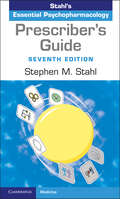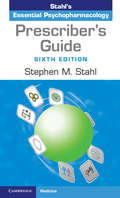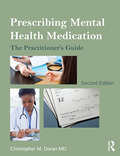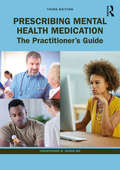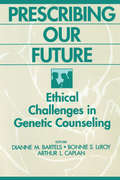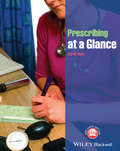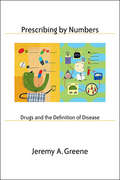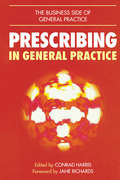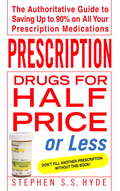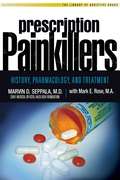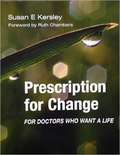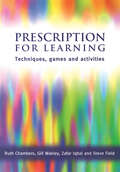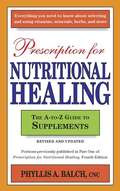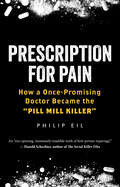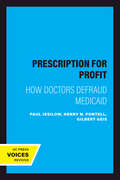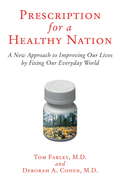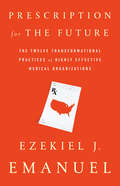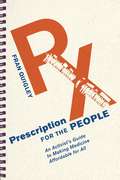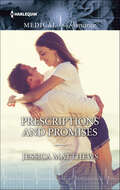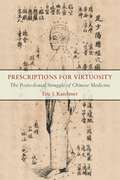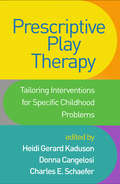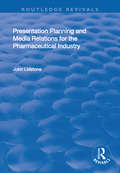- Table View
- List View
Prescriber's Guide: Stahl's Essential Psychopharmacology (Stahl's Essential Psychopharmacology Handbooks Ser.)
by Stephen M. StahlWith the range of psychotropic drugs expanding and the usages of existing medications diversifying, we are pleased to present the Seventh Edition of the world's best-selling formulary in psychopharmacology. The new edition features nine new compounds as well as information about several new formulations of existing drugs. Many important new indications are covered for existing drugs, as are updates to the profiles of the entire content and collection, including new injectable and transdermal formulations, as well as updated warnings and indications. The Pearls have all been refreshed and the antipsychotics section has been completely revised. With its easy-to-use, full-colour template-driven navigation system, Prescriber's Guide combines evidence-based data with clinically informed advice to support everyone who is prescribing in the field of mental health.
Prescriber’s Guide (Sixth Edition)
by Stephen M. Stahl Meghan M. Grady Nancy MuntnerEssential Neuropharmacology: The Prescriber's Guide expertly reviews the most important medications used by neurologists in their practice. Experienced clinicians share their expert knowledge about the best use of medications in patient care. Each drug listing contains the range of indications, their advantages and disadvantages, and tips for dosing and avoiding adverse effects. Experts in fields such as multiple sclerosis, movement disorders, neuromuscular disorders, epilepsy, stroke, pain and headache summarize how neurologists use these medications to their best effect, and discuss off-label uses in neurology. Evidence is taken from recent clinical trials, which helps the reader relate the content to everyday clinical practice. The detailed descriptions of each medication enable the user to make quick and informed decisions with the confidence they need to best serve the clinical needs of their patients. This book is an essential, user-friendly reference suitable for all neurologists at all stages of their careers.
Prescriber’s Guide Antidepressants: Stahl's Essential Psychopharmacology (Essential Psychopharmacology Ser.)
by Stephen M. Stahl Meghan M. Grady Nancy Muntner Stephen M. Stahl Meghan M. Grady Nancy MuntnerThis spin-off from Stephen Stahl's new, completely revised, and fully updated fourth edition of the Prescriber's Guide covers the most important drugs in use today for treating depression. Now established as the indispensable formulary in psychopharmacology, easy to navigate and easy to use, the Prescriber's Guide combines evidence-based information with clinically-informed guidance to support clinicians in making the most effective prescribing decisions for the good of their patients. Incorporating information on the newest indications, new formulations, new recommendations and new safety data, this edition continues to provide the essential practical support required by anyone prescribing in the field of mental health.
Prescribing Mental Health Medication: The Practitioner's Guide
by Christopher M. DoranPrescribing Mental Health Medication is a text for practitioners who treat mental disorders with medication. It explains the entire process of medication assessment, management and follow up for general medical practitioners, mental health practitioners, students, residents, prescribing nurses and others perfecting this skill. Already used by providers and training institutions throughout the world, the newly revised second edition is completely updated and focuses on the following key issues: How to determine if medication is needed Proper dosing and how to start and stop medication When to change medication Dealing with difficult patients Specific mental health symptoms and appropriate medication Special populations including pregnant women, substance abusers, children and adolescents, and the elderly Monitoring medication with blood levels Management of medication side effects and avoidance of medication risk The misuse of medication Prescription of generic preparations Prescriptions via the Internet, telemedicine, and electronic medical records Organizing a prescriptive office and record-keeping Completely updated, this text includes information on all psychotropic medications in use in the United States and the United Kingdom. It incorporates clinical tips, sample dialogues for talking about medications to patients, and information specifically relevant in primary care settings.
Prescribing Mental Health Medication: The Practitioner's Guide
by Christopher M. Doran MDPrescribing Mental Health Medication is a comprehensive text for all practitioners who treat mental disorders with medication. This new (third) edition is fully updated and includes a variety of additional chapters. Prescribing Mental Health Medication covers the latest digital methodologies including Internet-based mental health treatment, electronic medical records and prescriber use of social media. Including information on all psychotropic medications in use in the United States and the United Kingdom, the book incorporates clinical tips, sample dialogues for talking about mental health medications to patients, and information specifically relevant in primary care settings. It looks at: • how to determine if medication is needed, proper dosing and how to start, stop and change medication • specific mental health symptoms and appropriate medication • special populations including non-adherent patients, medication abusers, those mixing alcohol and psychotropics, confused patients, children, adolescents, pregnant women and seniors • management of medication side effects and avoidance of medication risk • prescription of generic preparations • organizing a prescriptive office and record keeping. The additional chapters in this new edition of Prescribing Mental Health Medication cover topics such as combining specific medications, combining medications and psychological therapies, use of 'natural' substances in mental health treatment, successfully managing patient relapse, and appropriate prescriptions of potentially controversial medications such as stimulants and benzodiazepines. This practical text explains the entire process of medication assessment, management and follow up for general medical practitioners, mental health practitioners, students, residents, prescribing nurses and others perfecting this skill.
Prescribing Our Future: Ethical Challenges in Genetic Counseling
by Diane M. Bartells Bonnie LeRoyGenetic counselors translate the findings of scientific investigation into meaningful accounts that enable individuals and families to make decisions about their lives. This collection of original papers explores the history, values, and norms of that process, with some focus on the value of nondirectiveness in counseling practice. The contributors; examination of genetic counseling issues serves as a foundation from which to address other ethical, legal, and policy considerations in the expanding universe of clinical genetics.
Prescribing at a Glance
by Sarah RossThe principles of drug therapies are fundamental to medical practitioners in all branches; but are often difficult to get to grips with. Prescribing at a Glance addresses the most common uses of prescription drugs, and follows progress from dose calculation, administration to monitoring the effects in the treatments of major presenting problems.With a focus on prescribing, this user-friendly guide helps practitioners to develop crucial knowledge and skills, including establishing accurate drug histories, planning appropriate therapies, writing safe and legal prescriptions, critically appraising the prescribing of others, patient support, accessing reliable information about medicines, and detecting adverse drug reactions.Prescribing at a Glance:* Features detailed and high-quality colour illustrations throughout* Includes examples of common prescribing errors, practice prescriptions and calculations* Follows the structure of the WHO Good Prescribing Guide, and corresponds to the core curriculum of the British Pharmacological Society* Is the perfect guide to help you prepare for the Prescribing Skills Assessment (PSA)* Includes a companion website featuring interactive MCQs and cases, available at www.ataglanceseries.com/prescribingFrom the series that brought you Medical Pharmacology at a Glance, and designed to help those in the later stages of their medical training become adept at the skills required for a vital yet often confusing subject - Prescribing at a Glance will help you fill in any knowledge gaps with simple step-by-step instructions, and clear, easy-to-remember guidelines.
Prescribing by Numbers: Drugs and the Definition of Disease
by Jeremy A. GreeneWinner, 2009 Rachel Carson Prize, Society for the Social Studies of ScienceWinner, 2012 Edward Kremers Award, American Institute of the History of PharmacyThe second half of the twentieth century witnessed the emergence of a new model of chronic disease—diagnosed on the basis of numerical deviations rather than symptoms and treated on a preventive basis before any overt signs of illness develop—that arose in concert with a set of safe, effective, and highly marketable prescription drugs. In Prescribing by Numbers, physician-historian Jeremy A. Greene examines the mechanisms by which drugs and chronic disease categories define one another within medical research, clinical practice, and pharmaceutical marketing, and he explores how this interaction has profoundly altered the experience, politics, ethics, and economy of health in late-twentieth-century America. Prescribing by Numbers highlights the complex historical role of pharmaceuticals in the transformation of disease categories. Greene narrates the expanding definition of the three principal cardiovascular risk factors—hypertension, diabetes, and high cholesterol—each intersecting with the career of a particular pharmaceutical agent. Drawing on documents from corporate archives and contemporary pharmaceutical marketing literature in concert with the clinical literature and the records of researchers, clinicians, and public health advocates, Greene produces a fascinating account of the expansion of the pharmaceutical treatment of chronic disease over the past fifty years. While acknowledging the influence of pharmaceutical marketing on physicians, Greene avoids demonizing drug companies. Rather, his provocative and comprehensive analysis sheds light on the increasing presence of the subjectively healthy but highly medicated individual in the American medical landscape, suggesting how historical analysis can help to address the problems inherent in the program of pharmaceutical prevention.
Prescribing in General Practice
by Conrad M HarrisManagement controls on prescribing have greater impact on a GP's freedom of choice than on any other matter requiring clinical judgement. However, in order to deliver the most effective patient care, the GP needs a much broader base of knowledge including, for example, an understanding of basic pharmacological principles and the process of conducting clinical trials. This book deals systematically with the practical aspects of prescribing throughout primary care. It provides the busy GP with readily-accessible information so that the benefit to patients and the pratice can be maximized.
Prescription Drugs for Half Price or Less
by Stephen HydeIf you want to save up to 50, 70, even 90% on your prescription drug costs, this is the book you need. Stephen S. S. Hyde, founder of Hyde Rx Services Corporation, is the leading authority on low-cost prescription drug benefits, and now he's offering individual consumers the expertise he provides to America's employers and health plans. With the simple, cost-saving techniques outlined in this revolutionary book, you can save literally hundreds, even thousands of dollars on your family's prescription medications. You'll discover:* The seven questions you should ask your doctor before he writes a prescription * How your pharmacist can save you money * How to get FREE prescription drugs * How to save on generic, over-the-counter, and brand-name drugs * How to get the lowest prices from retail, mail-order, online, and Canadian pharmacies * How you may be eligible for discount cards and other assistance programs * A Special Seniors Medicare Drug Benefit Report, and much more!With an appendix of directories, pharmacies, and websites to get you started, this book will pay for itself with your very first prescription!From the Trade Paperback edition.
Prescription Painkillers: History, Pharmacology, and Treatment
by Marvin D Seppala Mark E. RoseThe definitive book about the impact of prescription painkiller abuse on individuals, communities, and society by one of America's leading experts on addiction.In recent years, the media has inundated us with coverage of the increasing abuse of prescription painkillers. Prescription Painkillers, the third book in Hazelden's Library of Addictive Drugs series, offers current, comprehensive information on the history, social impact, pharmacology, and addiction treatment for commonly abused, highly addictive opiate prescription painkillers such as Oxycontin®, Vicodin, Percocet, and Darvocet.Marvin D. Seppala, MD, provides context for understanding the current drug abuse problem by tracing the history of opioids and the varying patterns of use over time. He then offers an in-depth study of controversial issues surrounding these readily available drugs, including over-prescription by physicians and adolescent abuse. Also included is a straightforward look at the leading treatment protocols based on current research.
Prescription for Change for Doctors Who Want a Life: For Doctors Who Want A Life
by Susan E KersleyPrescription for Change for Doctors Who Want a Life promotes a healthy work/life balance. It is a practical, easy-to-read guide containing useful tools and advice with specific references to medical scenarios written in a straightforward style. Susan E Kersley is a qualified doctor and regularly writes for BMJ Career Focus, speaks at the BMJ Careers Fair, and runs workshops on personal development and self-care for doctors. Doctors of all grades and specialties will find this philosophy invaluable, as will medical mentors, careers advisors and counsellors.
Prescription for Heterosexual
by Carolyn Herbst LewisIn this lively and engaging work, Carolyn Lewis explores how medical practitioners, especially family physicians, situated themselves as the guardians of Americans' sexual well-being during the early years of the Cold War. She argues that many doctors viewed their patients' sexual habits as more than an issue of personal health. They believed that a satisfying sexual relationship between heterosexual couples with very specific attributes and boundaries was the foundation of a successful marriage, a fundamental source of happiness in the American family, and a crucial building block of a secure nation. Drawing on hundreds of articles and editorials in medical journals as well as other popular and professional literature, Lewis traces how medical professionals defined and reinforced heterosexuality in the mid-twentieth century, giving certain heterosexual desires and acts a veritable stamp of approval while labeling others as unhealthy or deviant. Lewis links their prescriptive treatment to Cold War anxieties about sexual norms, gender roles, and national security. Doctors of the time, Lewis argues, believed that "unhealthy" sexual acts, from same-sex desires to female-dominant acts, could cause personal and marital disaster; in short, says Lewis, they were "un-American. " In this lively and engaging work, Carolyn Lewis explores how medical practitioners, especially family physicians, situated themselves as the guardians of Americans' sexual well-being during the early years of the Cold War. She argues that many doctors viewed their patients' sexual habits as more than an issue of personal health. They believed that a satisfying sexual relationship between heterosexual couples with very specific attributes and boundaries was the foundation of a successful marriage, a fundamental source of happiness in the American family, and a crucial building block of a secure nation. Drawing on hundreds of articles and editorials in medical journals as well as other popular and professional literature, Lewis traces how medical professionals defined and reinforced heterosexuality in the mid-twentieth century, giving certain heterosexual desires and acts a veritable stamp of approval while labeling others as unhealthy or deviant. Lewis links their prescriptive treatment to Cold War anxieties about sexual norms, gender roles, and national security. Doctors of the time, Lewis argues, believed that "unhealthy" sexual acts, from same-sex desires to female-dominant acts, could cause personal and marital disaster; in short, says Lewis, they were "un-American. "
Prescription for Learning: Learning Techniques, Games and Activities
by Zafar Iqbal Ruth Chambers Gill Wakley Steve FieldThis book consists of more than 400 questions (multiple true-false and extended matching types) covering basic surgical sciences and clinical general surgery in an integrated fashion. As well as all the major areas of surgery other topics covered include pre-operative assessment anaesthesia intensive care trauma surgical oncology and post-operative complications. Short answers to all the questions are included. Although aimed at candidates preparing for Papers 1 and 2 of the new MRCS AFRCS and American Board examinations others such as undergraduate medical students and GPs will also find the book valuable.
Prescription for Nutritional Healing: The A-to-Z Guide to Supplements
by Phyllis A. BalchThis book gives information on all the most important supplements available today. It details what a particular supplement is, what forms it comes in and how to use it, as well as when not to use it.
Prescription for Pain: How a Once-Promising Doctor Became the "Pill Mill Killer"
by PHILIP EILAn obsessive true crime investigation of a bizarre and unlikely perpetrator, who&’s serving the opioid epidemic&’s longest term for illegal prescriptions — four life sentencesWritten in the tradition of I'll Be Gone in the Dark and True Crime Addict, combining Dopesick's heart rending portrayal of the epidemic's victims with Empire of Pain's examination of its perpetratorsThis haunting and propulsive debut follows a journalist&’s years-long investigation into his father's old classmate: former high school valedictorian Paul Volkman, who once seemed destined for greatness after earning his MD and his PhD from the prestigious University of Chicago, but is now serving four consecutive life sentences at a federal prison in Arizona.Volkman was the central figure in a massive &“pill mill&” scheme in southern Ohio. His pain clinics accepted only cash, employed armed guards, and dispensed a torrent of opioid painkillers and other controlled substances. For nearly three years, Volkman remained in business despite raids by law enforcement and complaints from patients&’ family members. Prosecutors would ultimately link him to the overdose deaths of 13 patients, though investigators explored his ties to at least 20 other deaths.This groundbreaking book is based on 12 years of correspondence and interviews with Volkman. Eil also traveled to 19 states, interviewed more than 150 people, and filed a Freedom of Information Act lawsuit against the Drug Enforcement Administration that led to the release of nearly 20,000 pages of trial evidence.The American opioid epidemic is, like this book, a true crime story. Through this one doctor&’s story, an era of unfathomable tragedy is brought down to a tangible, and devastating, human scale.
Prescription for Profit: How Doctors Defraud Medicaid
by Paul Jesilow Gilbert Geis Henry N. PontellIn this explosive exposé of our health care system, Paul Jesilow, Henry N. Pontell, and Gilbert Geis uncover the dark side of physician practice. Using interviews with doctors and federal, state, and private officials and extensive investigation of case files, they tell the stories of doctors who profit from abortions on women who aren't pregnant, of needless surgery, overcharging for services, and excessive testing.How can doctors, recipients of a sacred trust and sworn to the Hippocratic Oath, violate Medicaid so egregiously? The authors trace patterns of abuse to the program's inauguration in the mid 1960s, when government authorities, not individual patients, were entrusted with responsibility for payments. Determining fees and regulating treatment also became the job of government agencies, thus limiting the doctors' traditional role. Physicians continue to disagree with Medicare and Medicaid policies that infringe on their autonomy and judgment.The medical profession has not accepted the gravity or extent of some members' illegal behavior, and individual doctors continue to blame violations on subordinates and patients. In the meantime, program guidelines have grown more confusing, hamstringing efforts to detect, apprehend, and prosecute Medicaid defrauders. Failure to institute a coherent policy for fraud control in the medical benefit program has allowed self-serving and greedy practitioners to violate the law with impunity.Prescription for Profit is a shocking revelation of abuse within a once-hallowed profession. It is a book that every doctor, and every patient, needs to read this year.
Prescription for a Healthy Nation
by Tom Farley Deb CohenAmerica spends more than twice as much for health care as any other nation. So why are Americans among the sickest people in the industrialized world? Public health experts Tom Farley and Deborah A. Cohen show that the answer does not lie in our medical care system but rather in the world around us. As they explain, the leading killers of our time fall almost entirely into two categories: injuries and chronic diseases such as heart disease, lung and breast cancer, diabetes, and stroke. For all its inspiring, high-tech cures, modern medicine is just not very effective at combating these illnesses. Our health, as Farley and Cohen explain, depends much less on medicine than on how we lead our lives. And as their surprising and illuminating examples show, our behavior and our health are in fact shaped by our everyday world-from the design of our cities to the rules that govern our organizations.Obesity, for example, has emerged as a major health threat because our environment makes it difficult to be physically active and because prepared high-calorie foods-from chips and candy bars to fast food and "food on the go"-saturate our surroundings. Though we'd like to believe that we could stay slim through individual self-discipline, our everyday world overwhelms our resolve. In similar ways, the world around us influences whether we live our lives in ways that increase or decrease our chances of dying from killers as wide-ranging as cancer and car crashes. In the last part of the book, Farley and Cohen remind us of once-controversial changes to our physical environment that have saved tens of thousands of lives and outline many other ways in which we can change our daily environment so we can all live longer and healthier.Prescription for a Healthy Nation is at once an exposé of how various industries influence our health for the worse, a paradigm-shifting argument about health and disease, and a positive blueprint for how to create a healthier society.From the Hardcover edition.
Prescription for the Future: The Twelve Transformational Practices of Highly Effective Medical Organizations
by Ezekiel J. Emanuel J EmanuelHow can America's healthcare system be transformed to provide consistently higher-quality and lower-cost care? Nothing else in healthcare matters more. Prescription for the Future identifies some standout medical organizations that have achieved higher-quality, more patient-focused, and lower-cost care, and from their examples distills twelve transformational practices that could transform the entire healthcare sector. Ezekiel J. Emanuel looks at individual physician practices and organizations who are already successfully driving change, and the specific practices they have instituted. They are not the titans everyone seems to know and assume to be the "best"; instead, Emanuel has chosen a select group--from small physician offices to large multi-specialty group practices, accountable care organizations, and even for-profit companies--that are genuinely transforming care. Prescription for the Future shines a bright diagnostic light on the state of American healthcare and provides invaluable insights for healthcare workers, investors, and patients. The book gives all of us the tools to recognize the places that will deliver high-quality, effective care when we need it.
Prescription for the People: An Activist’s Guide to Making Medicine Affordable for All (The Culture and Politics of Health Care Work)
by Fran QuigleyIn Prescription for the People, Fran Quigley diagnoses our inability to get medicines to the people who need them and then prescribes the cure. He delivers a clear and convincing argument for a complete shift in the global and U.S. approach to developing and providing essential medicines—and a primer on how to make that change happen. Globally, 10 million people die each year because they are unable to pay for medicines that would save them. The cost of prescription drugs is bankrupting families and putting a strain on state and federal budgets. Patients’ desperate need for affordable medicines clashes with the core business model of the powerful pharmaceutical industry, which maximizes profits whenever possible. It doesn’t have to be this way. Patients and activists are aiming to make all essential medicines affordable by reclaiming medicines as a public good and a human right, instead of a profit-making commodity. In this book, Quigley demystifies statistics and terminology, offers solutions to the problems that block universal access to medicines, and provides a road map for activists wanting to make those solutions a reality.
Prescriptions and Promises
by Jessica MatthewsSome promises just had to be broken!Jenny Ruscoe had always believed in standing by her word, but keeping her, uncle's pharmacy open as she had promised him was going to be impossible.Or so she thought, until Dr. Noah Kimball tore a strip off her for depriving Springwater of its only pharmacy. It was persuasion enough to change her mind. Jenny intended instead to place a manager in charge and leave at the end of the summer--unless Noah could change her mind about that, too. Jenny was beginning to think that this compelling man could talk her into just about anything!
Prescriptions for Virtuosity: The Postcolonial Struggle of Chinese Medicine
by Eric I. KarchmerAlthough Chinese medicine is assumed to be a timeless healing tradition, the encounter with modern biomedicine threatened its very existence and led to many radical changes. Prescriptions for Virtuosity tells the story of how doctors of Chinese medicine have responded to the global dominance of biomedicine and developed new forms of virtuosity to keep their clinical practice relevant in contemporary Chinese society.Based on extensive ethnographic and historical research, the book documents the strategies of Chinese medicine doctors to navigate postcolonial power inequalities. Doctors have followed two seemingly contradictory courses of action. First, they have emphasized the unique “Chinese” characteristics of their practice, defining them against the perceived strengths of biomedicine, and producing an ontological divide between the two medical systems. These oppositions have inadvertently marginalized Chinese medicine, making it seem appropriate for clinical use only when biomedical solutions are lacking. Second, doctors have found points of convergence to facilitate the blending of the two medical practices, producing innovative solutions to difficult clinical problems.Prescriptions for Virtuosity examines how the postcolonial condition can generate not only domination but hybridity. Karchmer shows, for example, how the clinical methodology of “pattern discrimination and treatment determination” bianzheng lunzhi, which is today celebrated as the quintessential characteristic of Chinese medicine, is a twentieth-century invention. When subjected to the institutional standardizations of hospital practice, bianzheng lunzhi can lead to an impoverished form of medicine. But in the hands of a virtuoso physicians, it becomes a dynamic tool for moving between biomedicine and Chinese medicine to create innovative new therapies.
Prescriptive Play Therapy: Tailoring Interventions for Specific Childhood Problems
by Charles E. Schaefer Heidi Gerard Kaduson Donna CangelosiThis book helps practitioners choose from the broad range of play therapy approaches to create a comprehensive treatment plan that meets the individual needs of each child. From leaders in the field, the volume provides a flexible roadmap for assessment, case formulation, and intervention for frequently encountered psychological disorders and adversities. The focus is creating a unique therapy "prescription" that is tailored to the child's presenting problems as well as his or her strengths, challenges, and developmental level. Contributors present up-to-date knowledge on each clinical problem, describe practices that have been shown to be effective, and share vivid illustrations of work with 3- to 16-year-olds and their parents.
Present Knowledge in Nutrition
by Steven H. Zeisel Ian A. Macdonald John W. Erdman Jr.Present Knowledge in Nutrition, 10th Edition provides comprehensive coverage of all aspects of human nutrition, including micronutrients, systems biology, immunity, public health, international nutrition, and diet and disease prevention. <P><P>This definitive reference captures the current state of this vital and dynamic science from an international perspective, featuring nearly 140 expert authors from 14 countries around the world. Now condensed to a single volume, this 10th edition contains new chapters on topics such as epigenetics, metabolomics, and sports nutrition.The remaining chapters have been thoroughly updated to reflect recent developments. Suggested reading lists are now provided for readers wishing to delve further into specific subject areas. An accompanying website provides book owners with access to an image bank of tables and figures as well as any updates the authors may post to their chapters between editions. Now available in both print and electronic formats, the 10th edition will serve as a valuable reference for researchers, health professionals, and policy experts as well as educators and advanced nutrition students.
Presentation Planning and Media Relations for the Pharmaceutical Industry
by John LidstoneThis title was first published in 2003. Presenting information is a vital part of the job of both the medical director and other senior executives in the pharmaceutical industry, and yet the majority receive no training for this. Presentations have to be made internally to colleagues, clinical staff, marketing and product managers and medical sales representatives; and externally to professional medical specialists and NHS staff, the media and the general public. Anyone who manages or communicates adverse news needs to do so quickly and effectively, and be prepared to face difficult questions under media scrutiny. In this book, John Lidstone, an author acknowledged by the industry as an expert in marketing and presentation skills, provides readers with the tools and skills to make their presentations and media dealings a success. The book is divided into two parts.
